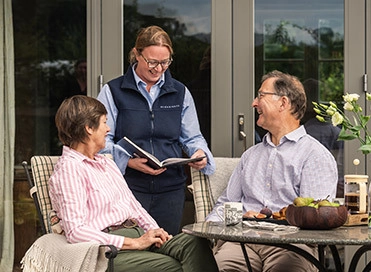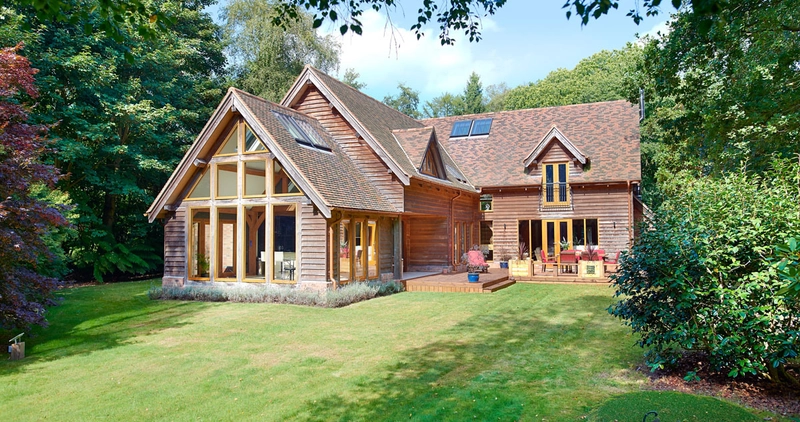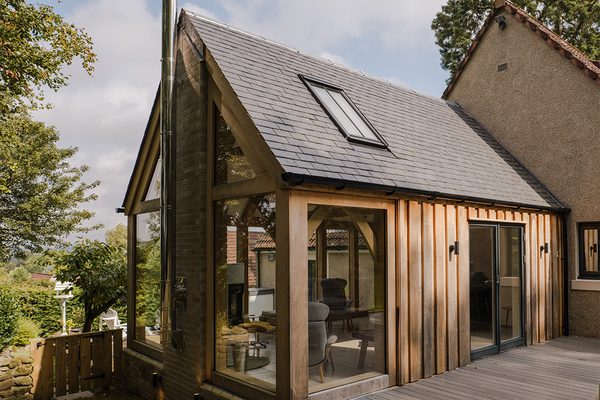
What is planning permission? Here's your guide...
We’re all familiar with the phrase itself, but what does it mean in relation to your upcoming project? Maybe you’re already researching plots for sale, or simply dreaming about the oak extension that’ll make you truly feel at home. Either way, you probably have plenty of questions about the importance of planning permission, and you’re eager to have answers.
It can be easy to find yourself scratching your head at the thought of planning permission, but that shouldn’t stop you from taking the crucial first steps on your oak frame journey. We’ve created this planning guide to help you navigate the planning permission process in confidence. We are here to support you through securing planning permission and offer guidance on the initial steps of crafting your vision.
Read on for our full guide to planning permission.


Do I need planning permission?
When you arrive at the exciting stage of submitting a planning application for your oak frame home, extension or outbuilding, you’re essentially asking for approval to construct a final design.
Planning permission applications are considered by local planning authorities, typically your local council, concerning plans to build, change or demolish a building or property. If you’re attempting to build an entirely new home or alter an existing footprint (for example, you’d like to add a bespoke garden room or garage with a room above), you’ll require formal planning permission.
This process is designed to ensure any changes adhere to design and safety standards and align with local planning policies regarding considering and protecting the natural surrounding environment. This will vary from area to area, with different considerations being made depending on the make up, wildlife and accessibility of the area, among other factors.
As part of the planning process, our Architectural Team is here to support you with the process of understanding and submitting your application. It’s important to note some changes and constructions can fall under permitted development rules and do not require planning permission for work to begin. However, we always recommend obtaining a Certificate of Lawful Development to ensure any proposals fall under permitted development regulations.
We know you can’t wait to turn the key and unlock the door to your new home, so understandably you’re eager to know how long it will take to get your planning permission approved.
A number of factors can contribute to the time frame for approval for planning permission. Planning applications usually take 10 working days to be validated, and 8 weeks to receive notice of a decision. However, depending on the complexity of the project and workload of your public authority it can take anywhere from 6 months to a year to gain approval. Upon submission, your application will be assessed and validated.
The application is given a case number and allocated case officer, who will notify you in writing and make the application publicly available on your local authority’s website. Neighbouring projects will also be notified and be invited to share their comments. Depending on their proximity and the potential impact of your project, local neighbourhood groups, conservation area committees and resident’s associations will be offered the opportunity to share their thoughts. Once your planning permission has been granted, it will last up to three years from the date it is granted.

How to apply for planning permission in six steps
Before boots can start to get muddy and the hard work begins, you need to go through the process of applying for planning permission.
If you’d like us to provide a guiding hand through the planning permission journey, please reach out and we’ll offer our expertise and insights. In the meantime, Helen Needham, Head of Architecture here at Oakwrights, has put together a list of six essential steps to completing your application and how to navigate them.

1. Determine your planning application’s class
Before submitting a planning permission application, you must determine what class of planning application is needed for your new oak frame home. For example, is outline planning consent necessary or a full planning permission application required?
For more information on what level of planning permission your project will require, see our guide.
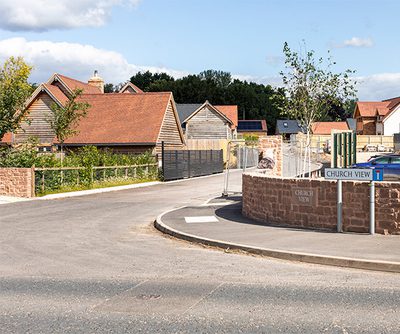
2. Open a line of communication
In the past, clients developing their self-build with the aim of creating a forever home have found it helpful to introduce themselves to potential neighbours, build a rapport and ingratiate themselves with the local community and decision makers. This shows you’re serious about building a life in the local area and working within its best interests.
Once you’ve finalised your bespoke design, the next step is considering whom it may be wise to contact ahead of submitting your application.
Notify neighbours, local committees and parish councils about your plans. They’ll appreciate the prior notice, rather than having to find out about your project from a notice board outside the site. It’s courteous, direct and will serve you well when it comes time to nestle into your new community and local surroundings.

3. Submit your application
Once you’ve pulled all your application documents together, it’s time to apply for planning.
Ensuring these documents are in line with planning validation procedures is imperative. This is an aspect a professional can guide you through and a service we regularly manage on behalf of our customers.

4. Get to know your planning officer
Many hands make a home, so strong relationships help perfect your bespoke design and ensure your project is streamlined. Building a rapport with the case officer assigned to your planning application is a great way to establish a dialogue and communicate the intricacies of your proposal.
Equally, it’s nice to give them time to look into your application, knowing you’ve provided them with all the documentation they need and that you’re just a phone call away if they have any questions.

5. Wait for a decision
Once your case officer has considered your application and it’s gone through the consultee period, your decision notice will be imminent! Sit back and wait for your notice to come through.
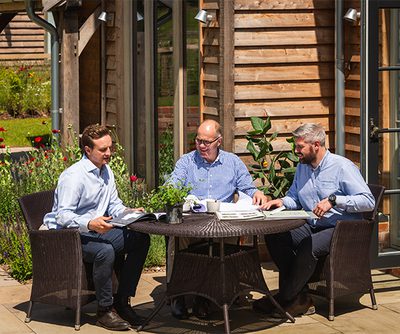
6. Move forward with planning permission approval
Having received your approved decision notice, it’s important to look into any planning conditions which may have been applied.
You must pay close attention to what is written here, as these conditions will determine how you can progress with constructing your oak frame home. Conditions you may see could include ‘pre-commencement conditions’ and ‘pre-occupation conditions’ (both of which you will find explained in our terms and acronyms guide later in at the bottom of this blog)
Once we’ve received and delivered the exciting news to our clients, we always guide them on their next steps and how we can assist them as their home building plans begin to take shape.
Your planning terms and acronyms guide:

There are 46 National Landscapes across England, Wales and Northern Ireland, which are protected by the Countryside and Rights of Way Act 2000 (CROW Act) due to their significant landscape value.
A backland plot refers to land that sits behind an existing property. Typically it won’t be visible from the road and is often a large residential garden.
Land which has been previously developed and is occupied by a permanent structure but is no longer in use is known as brownfield land, or a brownfield site.
Whereas planning permission assesses the potential impact of your project on your neighbour’s quality of life, scope to disrupt wildlife and alignment with national and local regulations, building permission covers the safety and structural implications of the development throughout the process.
These are a set of statutory standards in England and Wales which ensure new buildings and alterations made to existing buildings (domestic or commercial) will be safe, energy efficient, promote healthy living and will be built for purpose.
Building Control carries out checks to ensure buildings under construction are compliant with these standards and will issue Building Regulations approval.
If, for example, you’d like to change the use of a former agricultural barn into your future oak framed home, you’d generally need to obtain planning permission approval. We recommend you speak with a professional about your change of use aspirations.
Community Infrastructure Levy (CIL) is a local authorities charge imposed on new developments to fund public infrastructure, including roads, schools, and healthcare. A self-build exemption allows individuals building their own home to avoid this charge, provided they meet specific criteria, such as living in the property for at least three years.
These protect and preserve the special architectural or historic interest and the character and appearance of a place which make the area unique.
Historic England notes there are approximately 10,000 conservation areas in England.
This term primarily describes the ground and buildings immediately surrounding or next to a house or dwelling.
If or when you submit your planning application, your local planning authority will formally notify you with a written decision notice, and this will clearly state whether your planning application has been approved.
This is a short report that accompanies a planning application, and its purpose is to support and justify your proposal to your planning officer.
An environmental statement is prepared by you, the planning applicant, or the planning professional you’ve employed on your behalf. It is the assessment of the environmental impact of your build. What’s more, it’s part of an EIA, which is a process that’s carried out when it’s thought that construction may impact the environment.
This is the most common type of planning application. Within a full planning application, you submit all the details associated with your proposed new oak framed home.
Areas of countryside which are protected from most forms of development to prevent urban sprawl are known as green belt land.
Land which has not yet been developed or built on is called greenfield land.
A listed building or structure is deemed to have architectural or historic interest and they’re added to a national list to recognise their national importance. In England and Wales, there are three types of listed buildings: Grade I, Grade II, and Grade III.
Individuals within a council’s local planning authority are responsible for deciding whether the planning permission application for your future home build or sunroom extension should be granted.
This type of application requires fewer details about your proposed new build than a full planning application. An outline planning application is typically submitted at an early stage to find out whether a proposed development is likely to achieve planning approval from the local planning authority.
Permitted development rights allow homeowners to carry out certain changes to their homes, for example, in the form of an oak framed conservatory, without needing to submit a full planning permission application.
In place of refusing your application, your case officer may grant permission but with conditions attached that must be adhered to before building work can commence.
These are requirements issued by the council which must be met before you can live in your beautiful new family home.
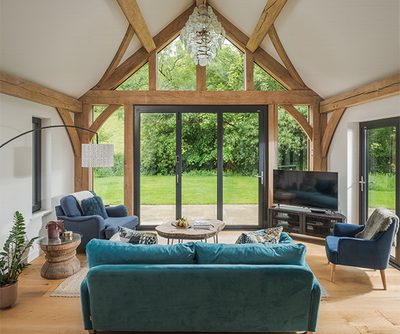
Crafting your own vision of personal serenity
Many of our customers, all coming from different walks of life, have designed their forever homes, each full of character and charm. Planning permission was just one stage in their oak projects - once permission was granted, the world became their oyster as they created something magical. Immerse yourself in our customers’ experiences and get excited at what’s to come.
Step inside our clients’ bespoke extensions…
Handpicked sources of inspiration for you

Open the door to your oak frame home journey
Whatever your home building plans may be, we’re here for you every step of the way. Explore the range of architectural services our team can offer, from bespoke oak framed home and extensions to charming outbuildings that uplift your property.
Get in touch with our team today to discuss your plans, explore plots of land for sale and begin a new chapter in your story.


